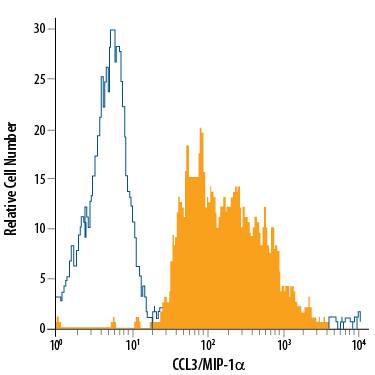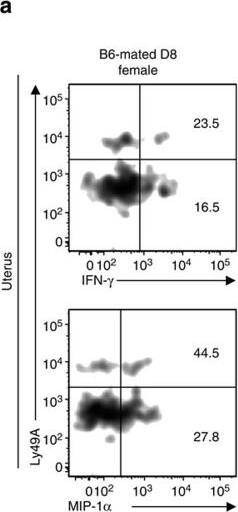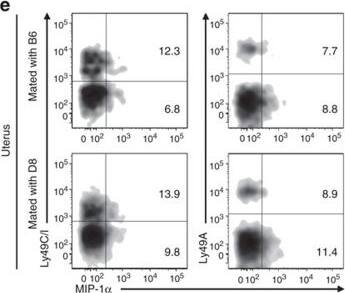Mouse CCL3/MIP-1 alpha APC-conjugated Antibody
R&D Systems, part of Bio-Techne | Catalog # IC450A


Key Product Details
Validated by
Species Reactivity
Validated:
Cited:
Applications
Validated:
Cited:
Label
Antibody Source
Product Specifications
Immunogen
Ala24-Ala92
Accession # P10855
Specificity
Clonality
Host
Isotype
Scientific Data Images for Mouse CCL3/MIP-1 alpha APC-conjugated Antibody
Detection of CCL3/MIP‑1 alpha in RAW 264.7 Mouse Cell Line by Flow Cytometry.
RAW 264.7 mouse monocyte/macrophage cell line treated with LPS was stained with Rat Anti-Mouse CCL3/MIP-1a APC-conjugated Monoclonal Antibody (Catalog # IC450A, filled histogram) or isotype control antibody (Catalog # IC006A, open histogram). To facilitate intracellular staining, cells were fixed with Flow Cytometry Fixation Buffer (Catalog # FC004) and permeabilized with Flow Cytometry Permeabilization/Wash Buffer I (Catalog # FC005). View our protocol for Staining Intracellular Molecules.Detection of Mouse CCL3/MIP-1 alpha by Flow Cytometry
Maternally derived H-2Dd also impedes fetal growth and vascular remodelling.(a) Density plots showing the proportion of IFN-gamma + or MIP-1 alpha+ uNK among cells positive or negative for Ly49A. (b–e) Fold-change in IFN-gamma - and MIP-1 alpha-producing cells among uNK expressing Ly49A compared with cells that do not. (b) Proportion of IFN-gamma + cells among cells expressing Ly49A compared with Ly49A−uNK (irrespective of expression of other Ly49). (c) Proportion of IFN-gamma + cells among cells expressing Ly49A compared with Ly49A−uNK (after exclusion of Ly49C/I+ cells). (d) Proportion of MIP-1 alpha+ cells among cells expressing Ly49A compared with Ly49A−uNK (irrespective of expression of other Ly49). (e) Proportion of MIP-1 alpha+ cells among cells expressing Ly49A compared with Ly49A−uNK (after exclusion of Ly49C/I+ cells). Pooled data from four experiments, n=6 mice. P-values comparing uNK subset expressing a given Ly49 with those that do not within each mouse using paired Student’s t-tests. Means±s.e.m. (f) Presence of smooth muscle actin around spiral arteries. Scale bar=100 μm. (g–j) Fetal growth is reduced in D8 females mated with either B6 (g) or D8 (i) males. Weights expressed as fraction of fetal weight in B6 × B6 controls. P-values for the effect of parental cross using a mixed model approach (taking into account inter-litter variability). Proportion of fetuses in or below the bottom 5% rank of controls (that is, ≤5th percentile) for D8 females mated with either B6 (h) or D8 (j) males. P-value from a χ2 test comparing the observed fraction with the expected value of 5%. Image collected and cropped by CiteAb from the following publication (https://www.nature.com/articles/ncomms4359), licensed under a CC-BY license. Not internally tested by R&D Systems.Detection of Mouse CCL3/MIP-1 alpha by Flow Cytometry
Paternal MHC does not educate uNK cells.(a) Density plots showing the proportion of IFN-gamma producing uNK (gd9.5+10.5) in response to NK1.1 cross-linking among cells positive or negative for the indicated Ly49 (irrespective of expression of other Ly49). (b–d) Fold change in IFN-gamma producing cells among uNK expressing the indicated Ly49 compared with cells that do not. Ly49C/I (b), Ly49A (c) and Ly49A after exclusion of Ly49C/I+ cells (d). (e) Density plots showing MIP-1 alpha producing uNK cells (gd9.5+10.5) in response to NK1.1 cross-linking among cells positive or negative for the indicated Ly49 (irrespective of expression of other Ly49). (f–h) Fold-change in MIP-1 alpha producing cells among uNK expressing the indicated Ly49 compared with cells that do not. Ly49C/I (f), Ly49A (g) and Ly49A after exclusion of Ly49C/I+ cells (h). Pooled data from two experiments, n=6–11 mice per group. P-values comparing uNK subset expressing a given Ly49 with those that do not within each mouse using paired Student’s t-tests. Means±s.e.m. Image collected and cropped by CiteAb from the following publication (https://www.nature.com/articles/ncomms4359), licensed under a CC-BY license. Not internally tested by R&D Systems.Applications for Mouse CCL3/MIP-1 alpha APC-conjugated Antibody
Intracellular Staining by Flow Cytometry
Sample: RAW 264.7 mouse monocyte/macrophage cell line treated with LPS was fixed with Flow Cytometry Fixation Buffer (Catalog # FC004) and permeabilized with Flow Cytometry Permeabilization/Wash Buffer I (Catalog # FC005)
Formulation, Preparation, and Storage
Purification
Formulation
Shipping
Stability & Storage
- 12 months from date of receipt, 2 to 8 °C as supplied.
Background: CCL3/MIP-1 alpha
The macrophage inflammatory proteins 1 alpha and 1 beta, two closely related but distinct proteins, were originally co-purified from medium conditioned by a LPS-stimulated murine macrophage cell line. Mature mouse CCL3/MIP-1 alpha shares approximately 77% and 70% amino acid identity with human CCL3/MIP-1 alpha and mouse CCL4/MIP-1 beta, respectively. MIP‑1 proteins are expressed primarily in T cells, B cells, and monocytes after antigen or mitogen stimulation. The MIP‑1 proteins are members of the beta (C‑C) subfamily of chemokines.
Both CCL3 and CCL4 are monocyte chemoattractants in vitro. Additionally, the MIP‑1 proteins have been reported to have chemoattractant and adhesive effects on lymphocytes, with CCL3 and CCL4 preferentially attracting CD8+ and CD4+ T cells, respectively. CCL3 has also been shown to attract B cells as well as eosinophils. MIP‑1 proteins have been reported to have multiple effects on hematopoietic precursor cells, and CCL3 has been identified as a stem cell inhibitory factor that can inhibit the proliferation of hematopoietic stem cells in vitro as well as in vivo. In the same assays, CCL4 was reported to be much less active. The functional receptor for CCL3 has been identified as CCR1 and CCR5.
References
- Menten, P. et al. (2002) Cytokine Growth Factor Rev. 13:455.
Alternate Names
Entrez Gene IDs
Gene Symbol
UniProt
Additional CCL3/MIP-1 alpha Products
Product Documents for Mouse CCL3/MIP-1 alpha APC-conjugated Antibody
Product Specific Notices for Mouse CCL3/MIP-1 alpha APC-conjugated Antibody
For research use only

